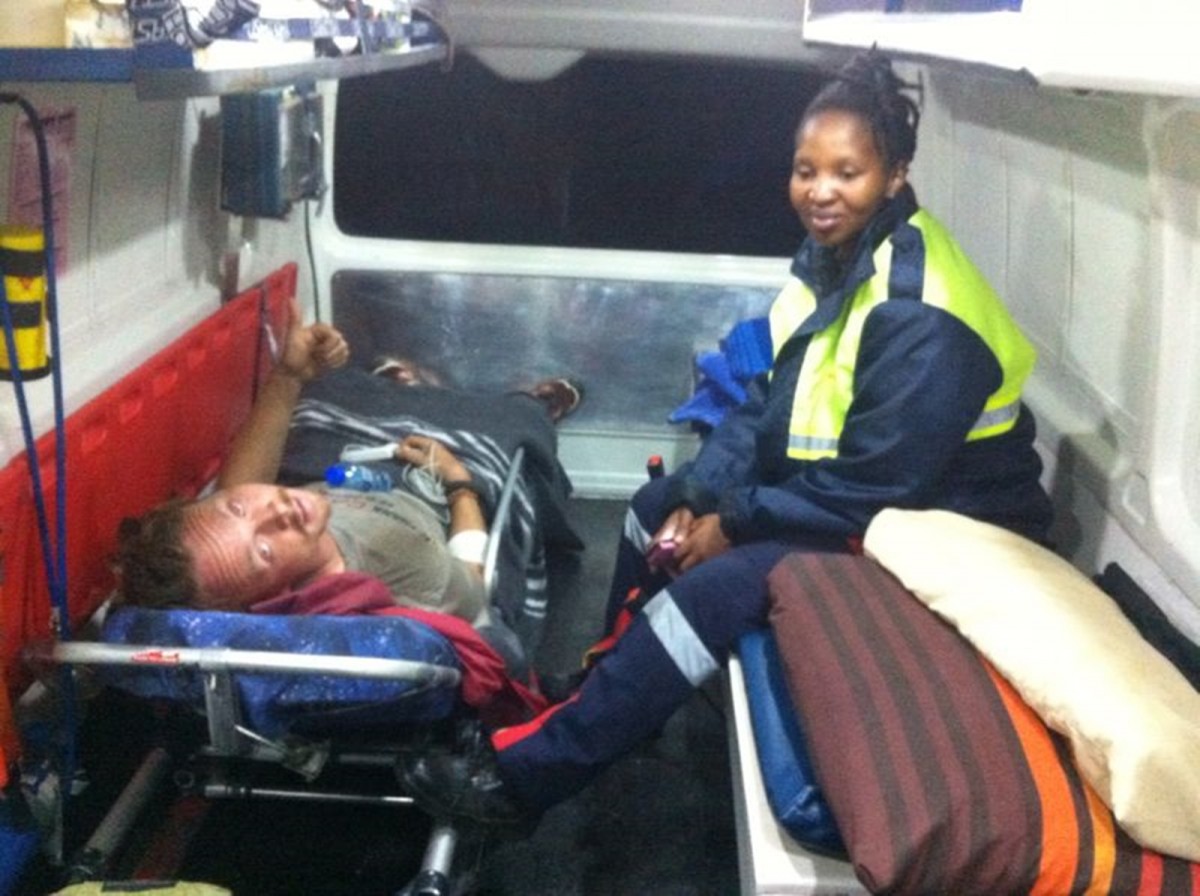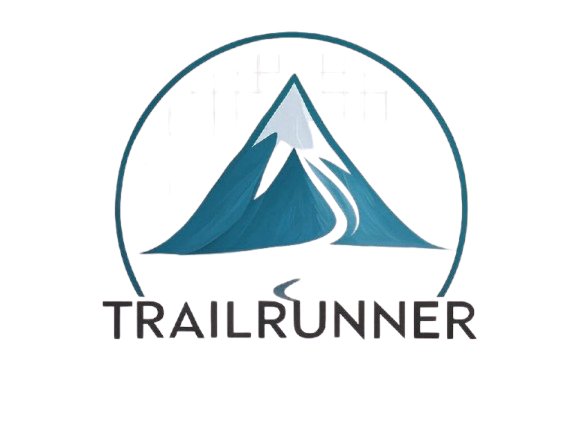On day 7 of the Drakensberg Grand Traverse, we get reminded of just how quickly an endeavour such as this can take an unexpected turn for the worse and force some rapid decision making and changes to the original plan. Written by Robert Lorriman and photographed by Pall Catt.
23 October – Thursday – Day seven
Our superb campsite was blessed with a fabulous morning vista, the flat layer of cloud just below us hiding the lowlands and leaving us to marvel at the pristine mountains without a hint of the interference of civilisation. Our day started along an easy path following the escarpment precipice almost floating along the blanket of cloud before we edged over the lip and away into the sweep of the broad Mokhotlong Valley. First steep then gently descending, the valley took us away from the escarpment into Lesotho. After about eight kilometres of pushing west, directly towards the heart of Lesotho the valley turned South to parallel the border. Where the Mokhotlong met the Redi from the east and the Mohlesi from the south, the valley broadened to nearly two kilometres across. The two lesser tributaries fed into the Mokhotlong, the reinforced river twisted North West away from the escarpment edge. We continued south up the valley of the Mohlesi towards our main objective of the day: the mightly Thabana-Ntlenyana, the highest mountain in Southern Africa at 3482 m.
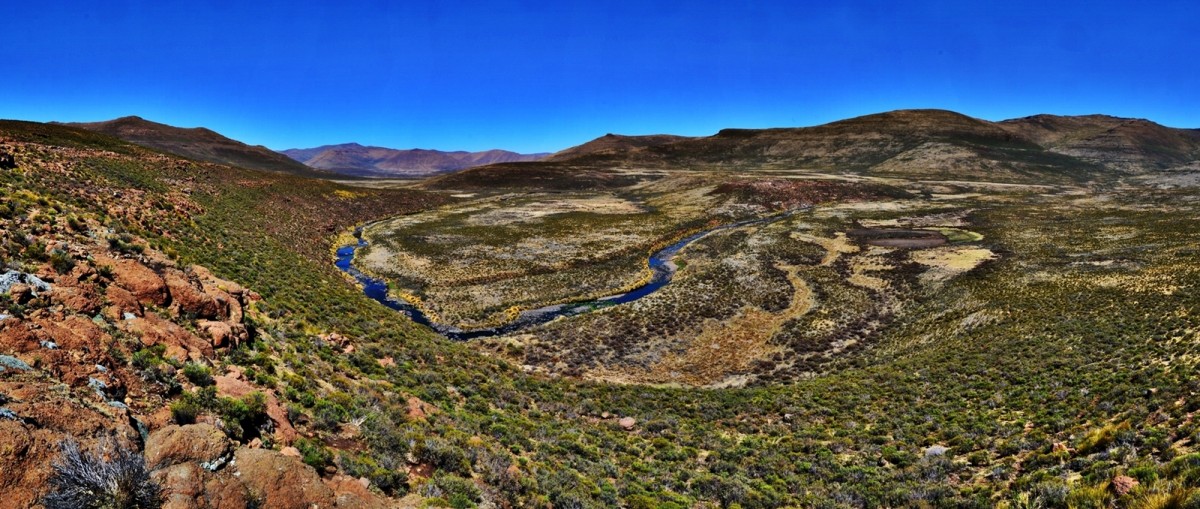
The day was hot and dry. We had camped at 3100m and the lowest point on the route was 2700m. Perhaps the altitude was to blame but I was feeling uncomfortably hot and physically feeble. Pall seemed strong and capable of pushing hard. We stopped five times for rests before stopping for a long lunch by a small stream, well concealed from inquisitive locals. Despite my efforts to the contrary, we had managed to cover 22 km by lunch and we felt confident that we should complete the eight kilometres to the final summit of the traverse and then a further three or so kilometres, to our planned camp for the night, without trouble.
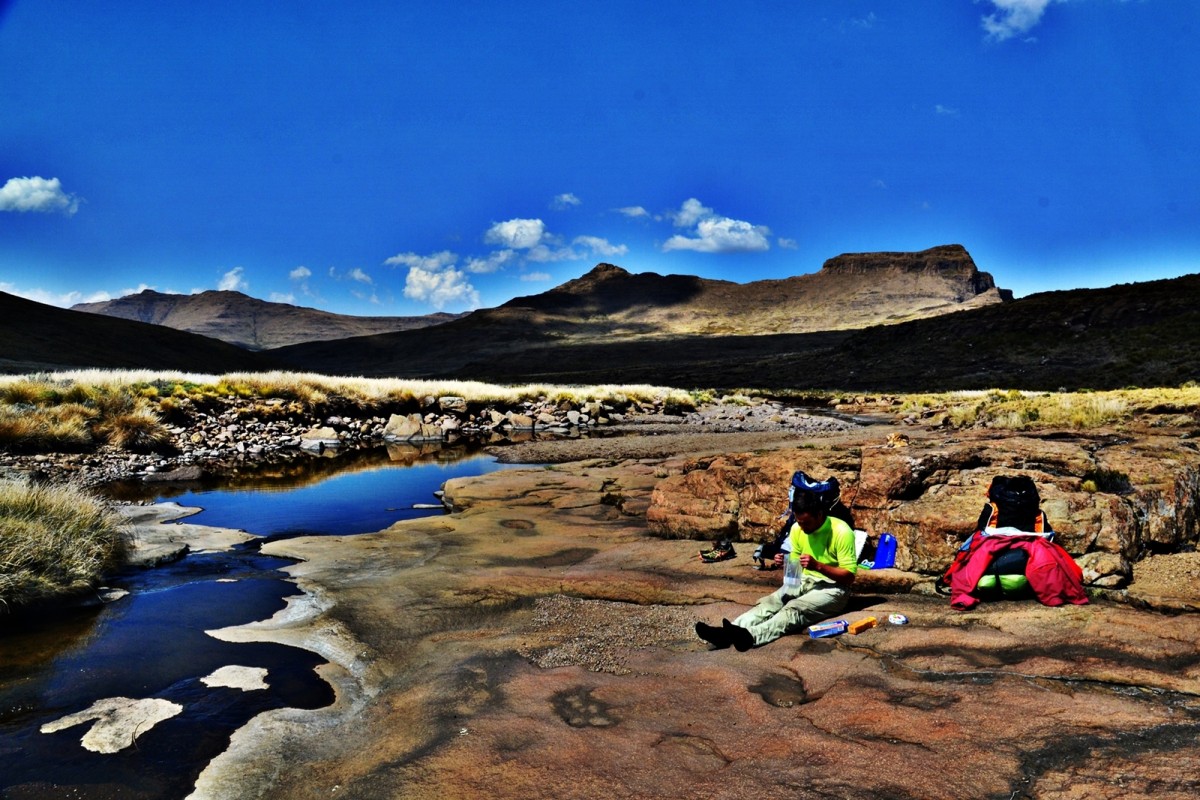
By now, we had had a number of encounters with small packs of dogs. Each little rondavel seemed to come with a complement of four or five Labrador sized mongrels who would get highly excited by our approach. So far all the encounters had played out the same way. The dogs would advance barking snarling and egging each other on. If the dogs got close enough to justify the effort, I would turn to face the approaching pack, bare my teeth and growl and snarl in my turn. Arms stretched wide and chest puffed out completed my little display. If this performance didn’t confirm my ‘bigger dog than you status’, I would make some short stabbing ‘warning charges’ to emphasise that I was confident of my success and should be allowed to pass unmolested. Pall didn’t share my beat aggression with aggression strategy. Instead he would ready his pepper spray, anticipating that this would quickly conclude any attack should it develop.
Very close to the main track to Thabana-Ntlenyana, we passed a rondavel that had been decorated with skins and trinkets. This was the first decoration that we had seen. Almost as soon as this unusual sight had registered we were met by the most aggressive pack of dogs yet. Their keeper appeared swiftly. He too was decorated. He wore jewellery and he had made an exceptional effort to tart up his clothing with trinkets and other ornaments. He controlled his dogs to some extent and asked us for cash, I can’t now remember but I think in exchange for a photograph which explained the unusual decoration. We were in no mood to hang around and declined his offer. His dogs’ interest in us continued for some time after his owner had returned with him to his rondavel. Growling and some well-aimed stones finally sent the dogs after their master.
Just beyond the decorated house, we moved a little way down the slope of the valley to fill up with water for the last five kilometres of walk and our camp for the night. Then began the final push to the summit. The going started steep and very quickly Pall started pushing ahead. Pall was probably no more than 100m ahead of me but out of sight to me as the slope rose first steeply and then less so and he was beyond the first steep section. As I passed the sharper slope and the ground begin to flatten, I saw Pall jogging towards me. He looked a touch pale and said in a calm voice, ‘That’s it, we have to go back, I’ve been bitten.’ I didn’t understand, Pall looked fine and I had learnt over the last week that he was mentally and physically very robust. I asked him if he was sure he couldn’t go on. At this point he began to explain what had happened to him in the previous sixty or so seconds and we both inspected his wounds: our traverse was definitely over and we needed to get moving: fast.
As he neared a rondavel, Pall had been approached by gang of five mongrels. With encounters of this nature being somewhat ordinary by this stage, he stood confidently and shouted at them to back away. It very quickly became apparent that this method was far less effective with him on his own than when the two of us together had done the same. Within seconds, the dogs had surrounded him and he sensed that he had lost control of the situation. He spun in circles, trying to fend off the advances that drew ever nearer from whichever direction his back was facing, until one bite caught his trouser leg, impeding his movement and opening up an opportunity for the other dogs to make their move. Destabilised somewhat by the heavy pack on his back, he lost his balance and was pulled to the ground. Pepper spray at the ready, he began to press on the trigger and caught three of the dogs in their faces and continued to wrestle with the others. He managed to get up but was once more pulled down. A dog clung on to his arm with its teeth, Pall managed to grab it but couldn’t bring himself to punch it as he didn’t feel that his life was in danger. In retrospect, Pall was one arterial puncture from an early end, he should have punched the dog. The rucksack on his back prevented the dogs from attacking his back once he was down. Luckily, the dogs’ young minders had appeared more quickly than usual and with the combined efforts of their jumping and screaming beside the scuffle, and Pall's pepper spray assisted resistance, the dogs finally retreated.
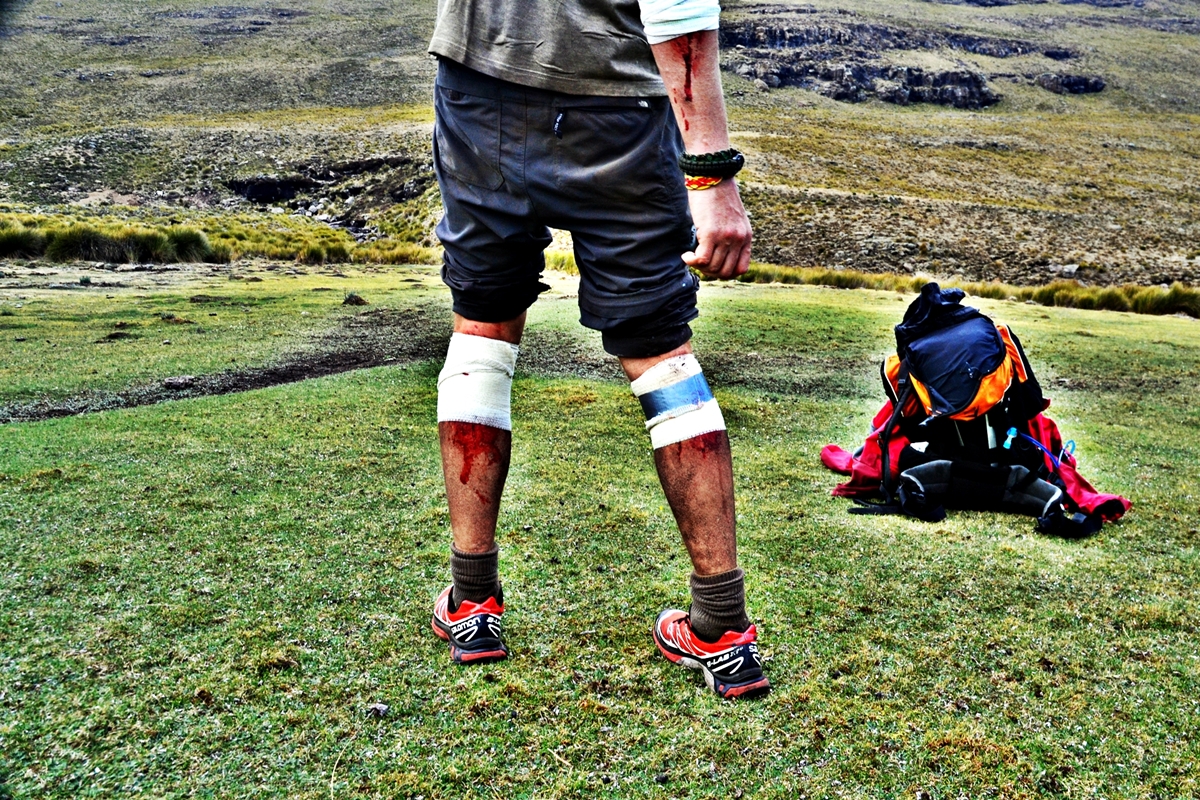
Pall had bites to his lower legs with deep gashes in his calves and round punctures to his shins. His right forearm and shoulder were also bitten. The blood was welling up in the wounds and streaming down his limbs. I had brought a number of wide crepe bandages to immobilise adder bites and broken bones. These were packed at the very top of my bag and now provided the perfect combination of direct pressure, all round compression and protection from the elements.

Pall’s phone had dropped from his trouser pocket during the melee. We searched for the phone. Pall found it quickly. Neither of us could get a signal. Our hoped for helicopter evacuation was thwarted but we expected to pick up a signal 3.5 km away overlooking South Africa at the edge of the escarpment.
We hefted on our packs and retraced our steps, this time passing well up the slope from the decorated house with its angry occupants. The day was cooling, we made rapid progress. Pall was going strong. It was just before five pm, when we reached the top of Mkhomazi Pass. No signal. We had roughly 90 minutes before dark. I climbed the short peak to the immediate north of the pass to improve my chances of getting line of sight to the mobile phone towers which I assumed lined the South African horizon to our east but still no signal.
Time was running out. We needed to decide. We could keep working to get mobile phone reception or push east into South Africa to search for help. If I tried the next closest peak, Mohlesi Rock, 1.5 km to the west and I failed to get a signal we would have to either spend the night on the escarpment or descend the precariously steep path marked on the map as ‘ill defined’ in darkness. Descending in the dark seemed an unreasonable risk. Pall still felt strong. Further delay would allow his wounds to stiffen and increase the opportunity for secondary infection to take hold. We had struggled with phone signal throughout the walk. We reached consensus quickly: we must push on the 16.5 km to a building marked Vergelegen OIC House. This plan allowed us to make the most of the remaining light to safely descend the first precipitous 550m of altitude loss. We assumed that OIC House meant the home of the Officer in Charge of the Vergelegen Wildlife Area, who could organise the help we needed.
We started the descent, Pall leading. I have always struggled on the downhills, Pall despite his injuries was soon well ahead of me. Ill-defined turned out to be correct. By the time that the winding difficult path began to level off at the bottom of the slope, we had both followed faint tracks off a good way only to have to correct our course with a corner cut or step retraced. Despite the frustration it was an immediate vindication of decision as darkness would have made it impossible.
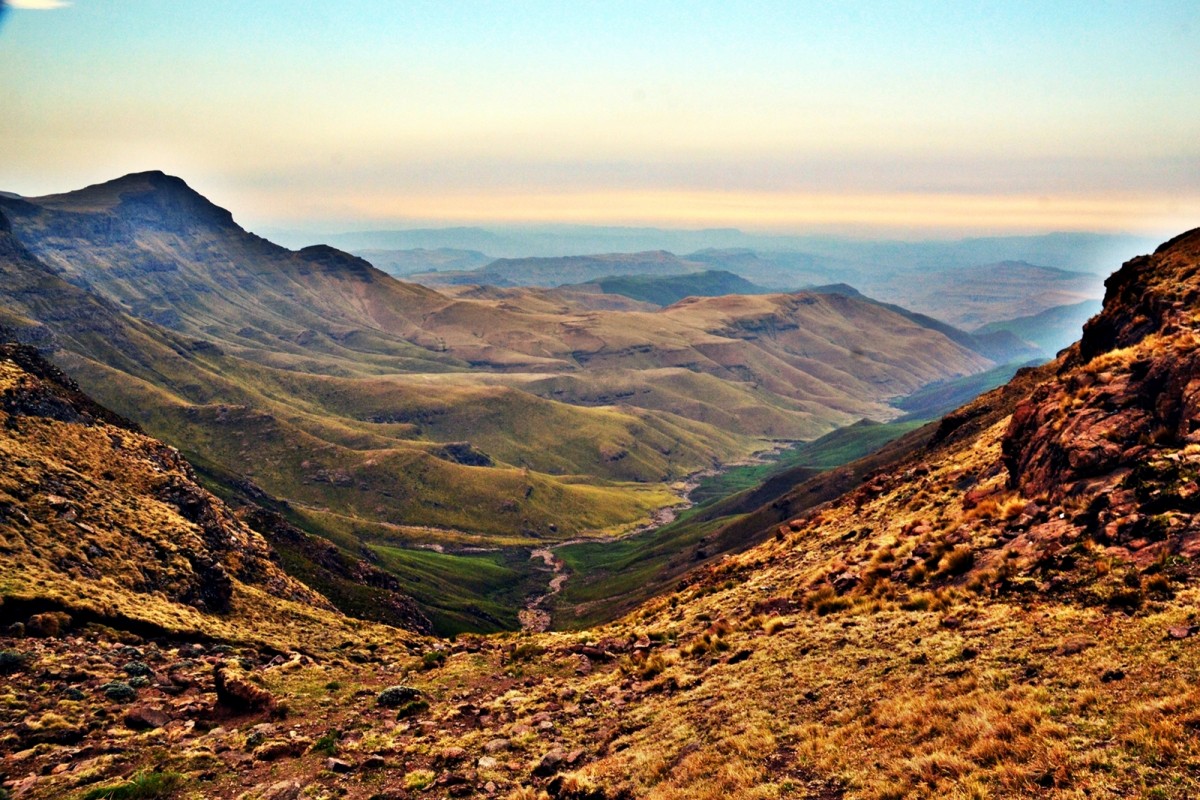
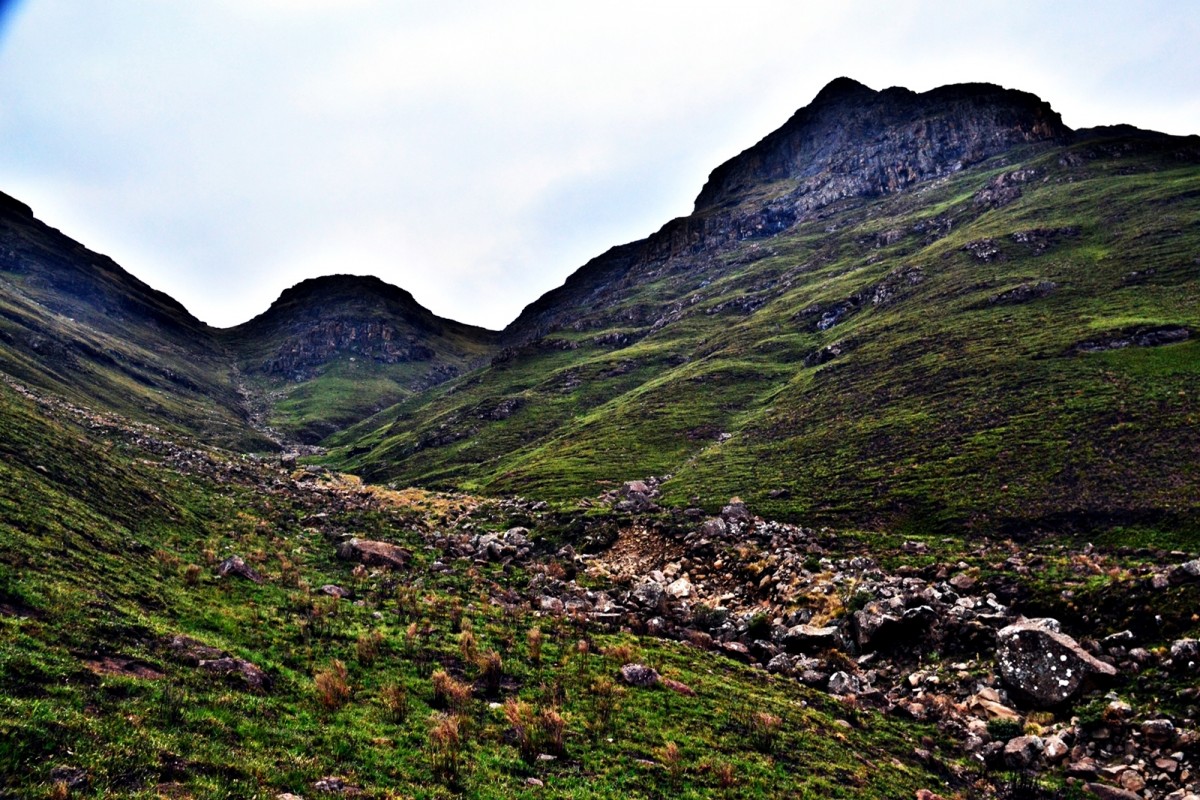
The following four and a half hours of march were tough. We had already completed our longest day. The air in the valleys was unpleasantly warm and humid. My ankles and knees, now subjected to constant uncoordinated twisting in the darkness were constantly complaining and begging me for respite. Pall was finally slowing, succumbing to the effects of his wounds. At critical points the path became ill-defined and map and ground were far from consistent. Without daylight to illuminate the massive mountain features, correcting for the cartographer’s misdemeanours became a time draining affair. Pacing from the end of features to locate a missed path junction (not marked as ‘ill-defined’ on the map), finding path junctions with streams which didn’t tally precisely with the map adding just that element of doubt when it was least needed.
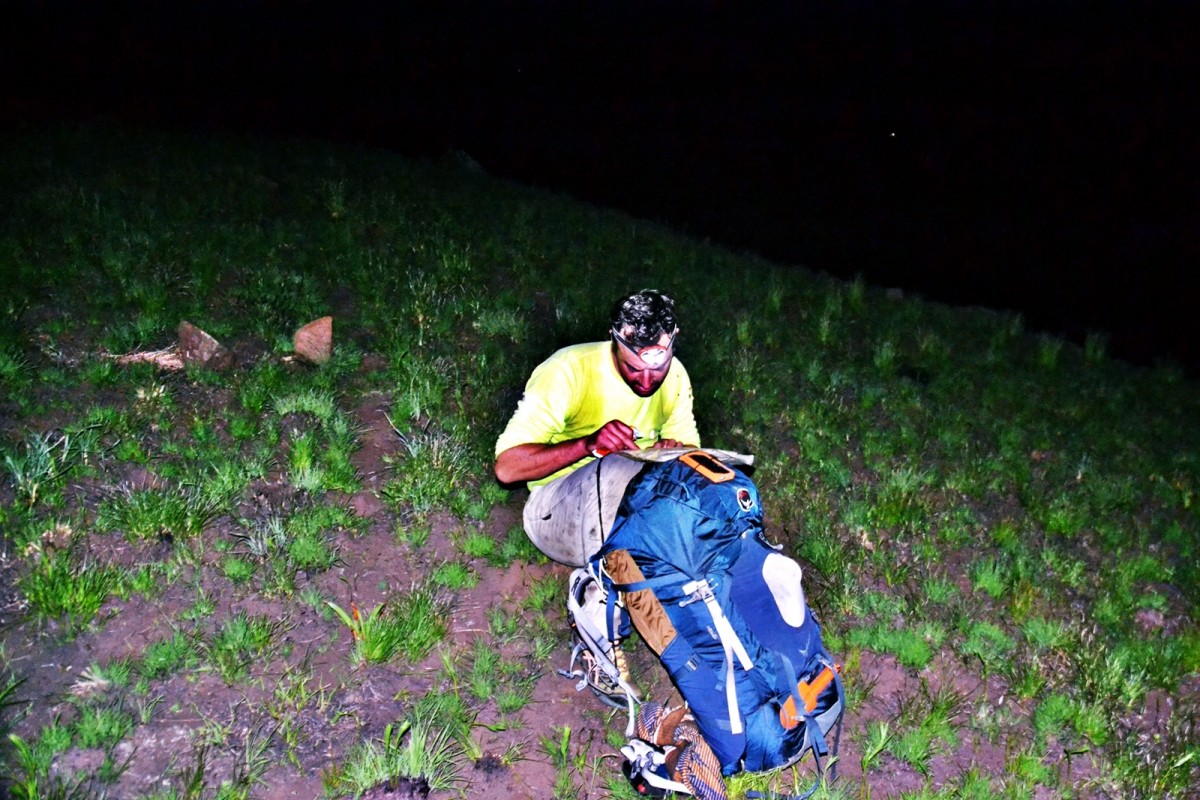
Finally we arrived at the OIC House. No-one was at home. The need to find a telephone signal returned. Finally, fortune favoured us. I got through to the Park authorities, made it clear that we had a medical emergency and an ambulance was dispatched. By this stage Pall's legs had completely seized up and he was unable to walk. I placed him in his sleeping bag and waited for the ambulance to arrive. A touch over two hours later the headlights of help appeared in the distance, guided by the OIC of an adjacent Park district. We manoeuvred Pall into the comfort of the ambulance and set off to the nearest private hospital in Pietermaritzburg. It was four in the morning, almost precisely 12 hours after the attack, when we arrived at the hospital. Following a period of negotiation and payment, Pall was cleaned up, patched up, and filled full of precautionary medicines of one sort or another. Pall’s parents trekked down from Pretoria to recover their son. Fortunately this greatly simplified the return to my vehicle, long since abandoned at the start of the endeavour.
